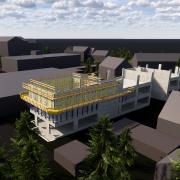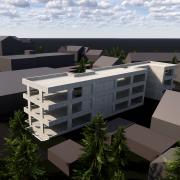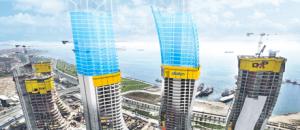Press Contact
Impressions
In BIM methodology, the entire building is digitally modelled from beginning to end before construction even starts. Errors and problems are spotted in the digital twin and eliminated before they can disrupt progress on the construction site. The project rigorously follows the principle of building the structure virtually first, and afterwards in reality.
Ground-breaking new method
BIM breaks new ground for Doka too. This is why for some years, the company has been studying how BIM applications can help match formwork solutions even more accurately to the construction process, thus contributing significantly to its success. A Competence Center was established and a team of experts brought together to assess the possibilities and the benefits of BIM. For about two years now, more than 800 formwork components from Doka have been online in the Tekla warehouse. Revit families have featured on the Doka homepage since last November. Currently, SharePoint, BIM 360 and Trimble Connect are used for data interchange with customers.
Practical application on the SOFiSTiK project in Germany
Construction software specialist SOFiSTiK AG is one of the pioneers of BIM in Germany. The company is planning and implementing its new office building in Nuremberg entirely with this innovative methodology. Lead contractor is WOLFF & MÜLLER Hoch- und Industriebau GmbH & Co. KG, who also has a great deal of experience in the BIM environment. Doka is supplying the formwork solution for the three-storey administrative building and retrospectively has an in-build integrated virtual formwork concept in place to assist construction. The design for the administrative block was drafted by architects GP Wirth Architekten.
The project was an ideal opportunity for Doka to gather experience and explore BIM in depth. One big advantage at the planning stage was the modular design and simple basic layout – there is little variation in the floor plans from storey to storey. Consequently, the Doka engineers soon had the formwork requirements integrated into their model. This was the ideal basis for mapping the formwork solution in BIM. Doka utilised the lead contractor’s data and models for mapping.
All the project stakeholders coordinated their work using the Autodesk Revit BIM software to ensure an end-to-end, efficient progress. Naturally, Doka also mapped its formwork in Revit. As a result, the risk of conversion losses while exchanging data was completely eliminated. Whenever stakeholders work with different BIM software packages, it is advisable to use the Industry Foundation Classes (IFC) format, which every BIM program can import and export. To gain experience in this field too, Doka exported the model for the SOFiSTiK office building in IFC format as well.
“BIM means building virtually first and then in reality. Thus, construction projects are easier to plan and you have more certainty in scheduling and costing. We are experienced in BIM and we like working with partners who share our enthusiasm for this method and want to help get it established. On the SOFiSTiK project, we found Doka to be a competent partner, committed to innovation and we are continuing our collaboration on further developing the BIM method”, says Thore Wolff, Operations Scheduling Manager at Wolff & Müller.
Visual support with 4D
The lead contractor also requested 4D simulation of the formwork planning. The 3D visualisation was enhanced by adding time as the fourth dimension. Not only was the structure itself simulated but also the entire sequence of events along the timeline, including start and finish dates and the timing of the individual phases of the building. The contractor can look at the stage of construction reached by any given milestone and monitor how progress on the build stays in sync with the original schedule. The information is unified and transparent, everyone involved is on the same page at all times.
In addition to the 4D simulation, Doka created a video (www.doka.com/sofistik) showing how the office building grows step by step. It is a visual aid assisting viewers get a better idea of the formwork logic and the construction procedure.
“Construction of the SOFiSTiK office building is an important project for Doka in terms of BIM. For us the project has huge potential for gathering practical experience with the BIM methodology and extending our expertise in this sector. We can put the new findings to good use in future projects. That in itself will help our clients optimise their construction routines”, says Martin Schneider, Doka’s BIM Coordinator Central Europe.
Formwork systems in use
Timber-beam floor formwork Dokaflex is used in construction of the office building. The system satisfies two essential requirements for jobsite operations: it is versatile and very easy to handle. Folding platform K ensures reliable protection for the site crew during construction operations. Pre-assembled units reduce working time and crane time by a huge margin.
Location: Nuremberg, Germany
Type of structure: Office building
Number of storeys: 3
Project owner: SOFiSTiK AG
Lead contractor: WOLFF & MÜLLER Hoch- und Industriebau GmbH & Co. KG
Architects: GP Wirth Architekten
Formwork planning: Doka Competence Center VDC/BIM (HQ Amstetten), Engineering & Deutsche Doka Schalungstechnik GmbH
Systems used: Products: Timber-beam floor formwork Dokaflex, Folding platform K
Services: BIM, 4D planning
Start of construction: August 2018
Completion: January 2019
Products and Solutions in use
This could also be of interest for you:
Do you have any questions on the article? Get in touch with us!






